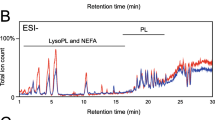Abstract
The replacement of medical-grade silicone with industrial-grade silicone material in some silicone gel-filled breast implants (SBI) manufactured by Poly Implant Prothèse and Rofil Medical Nederland B.V., reported in 2010, which resulted in a higher rupture tendency of these SBI, demonstrates the need for non-invasive, sensitive monitoring and screening methods. Therefore a sensitive method based on large volume injection–gas chromatography coupled to mass spectrometry (LVI-GC/MS) was developed to determine octamethylcyclotetrasiloxane (D4), decamethylcyclopentasiloxane (D5), and dodecamethylcyclo-hexasiloxane (D6) in blood samples from women with intact (n = 13) and ruptured SBI (n = 11). With dichloromethane extraction, sample cooling during preparation, and analysis extraction efficiencies up to 100 % and limits of detection of 0.03–0.05 ng D4–D6/g blood were achieved. Blood samples from women with SBI were investigated. In contrast to women with intact SBI, in blood from women with ruptured SBI higher D4 and D6 concentrations up to 0.57 ng D4/g blood and 0.16 ng D6/g blood were detected. With concentrations above 0.18 D4 ng/blood and 0.10 ng D6/g blood as significant criteria for ruptured SBI, this developed analytical preoperative diagnostic method shows a significant increase of the recognition rate. Finally a higher precision (error rate 17 %) than the commonly used clinical diagnostic method, mamma sonography (error rate 46 %), was achieved.

Comparison of the recognition rate of silicone breast implant failures via commonly used clinical diagnostic method (mamma sonography) and developed analytical method (determination of cyclic volatile siloxanes concentration in human blood with LVI-GC-MS)




Similar content being viewed by others
References
Varaprath S, Stutts D, Kozerski G. Silicon Chem. 2006;3:79–102.
Hurd CB. J Am Chem Soc. 1946;68:364–70.
Horii Y, Kannan K. Arch Environ Contam Toxicol. 2008;55:701–10.
Dudzina T, Von Goetz N, Bogdal C, Biesterbos JWH, Hungerbühler K. Environ Int. 2014;62:86–94.
Lykissa ED, Kala SV, Hurley JB, Lebovitz RM. Anal Chem. 1997;69:4912–6.
Brook MA. Biomaterials. 2006;27:3274–86.
Puskas JE, Luebbers MT. WIREs Nanomed Nanobiotechnol. 2012;4:153–68.
Flassbeck D, Pfleiderer B, Klemens P, Heumann KG, Eltze E, Hirner AV. Anal Bioanal Chem. 2003;375:356–62.
Kala SV, Lykissa ED, Neely MW, Lieberman MW. Am J Pathol. 1998;152:645.
Pfleiderer B, Moore A, Tokareva E, Ackerman JL, Garrido L. Biomaterials. 1999;20:561–71.
Eltze E, Bettendorf O, Rody A, Jackisch C, Herchenröder F, Böcker W, et al. J Biomed Mater Res A. 2003;64:12–9.
Wazir U, Kasem A, Mokbel K. Arch Plast Surg. 2015;42:4–10.
Lampert FM, Schwarz M, Grabin S, Stark GB. Geburtshilfe Frauenheilkd. 2012;72:243.
Wang DG, Alaee M, Steer H, Tait T, Williams Z, Brimble S, et al. Chemosphere. 2013;93:741–8.
Kierkegaard A, Van Egmond R, McLachlan MS. Environ Sci Technol. 2011;45:5936–42.
Sparham C, van Egmond R, Hastie C, O’Connor S, Gore D, Chowdhury N. J Chromatogr A. 2011;1218:817–23.
Utell MJ, Gelein R, Yu CP, Kenaga C, Geigel E, Torres A, et al. Toxicol Sci. 1998;44:206–13.
Flassbeck D, Pfleiderer B, Grümping R, Hirner AV. Anal Chem. 2001;73:606–11.
Xu L, Shi Y, Wang T, Dong Z, Su W, Cai Y. Environ Sci Technol. 2012;46:11718–26.
Xu L, Shi Y, Liu N, Cai Y. Sci Total Environ. 2015;505:454–63.
Companioni-Damas EY, Santos FJ, Galceran MT. Talanta. 2012;89:63–9.
Khan UD. Aesthet Plast Surg. 2008;32:684–7.
DIN Deutsches Institut für Normung EV (2008) DIN 32645 Nachweis-, Chemische Analytik Bestimmungsgrenze, Erfassungs- Begriffe, Wiederholbedingungen. Beuth Verlag, Berlin
Hanssen L, Warner NA, Braathen T, Odland J, Lund E, Nieboer E, et al. Environ Int. 2013;51:82–7.
Plotzke KP, Crofoot SD, Ferdinandi ES, Beattie JG, Reitz RH, Mcnett DA, et al. Drug Metab Dispos. 2000;28:192–204.
Scaranelo AM, Marques AF, Smialowski EB, Lederman HM. Sao Paulo Med J. 2004;122:41–7.
Hölmich LR, Friis S, Fryzek JP, Vejborg IM, Conrad C, Sletting S, et al. Arch Surg. 2003;138:801–6.
Rochira D, Cavalcanti P, Ottaviani A, Tambasco D. Ann Plast Surg. 2016;76:150–4.
Acknowledgments
The authors thank the patients who participated in this study and furthermore Macherey-Nagel, Axel Semrau, and Gerstel for their support.
Author information
Authors and Affiliations
Corresponding author
Ethics declarations
Compliance with Ethical Standards
ᅟ
Conflict of interest
None.
Conflict of interest
All research on human subjects presented in this paper was conducted in accordance with the ethical research standards prescribed by the responsible institutional committee on human experimentation and with the WMA Declaration of Helsinki as its 7th revision in 2013. Informed consent was obtained from all human subjects participating in the study.
Electronic supplementary material
Below is the link to the electronic supplementary material.
ESM 1
(PDF 166 kb)
Rights and permissions
About this article
Cite this article
Rosendahl, P., Hippler, J., Schmitz, O.J. et al. Cyclic volatile methylsiloxanes in human blood as markers for ruptured silicone gel-filled breast implants. Anal Bioanal Chem 408, 3309–3317 (2016). https://doi.org/10.1007/s00216-016-9401-7
Received:
Revised:
Accepted:
Published:
Issue Date:
DOI: https://doi.org/10.1007/s00216-016-9401-7




